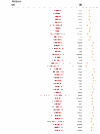Gene expression variation in Down's syndrome mice allows prioritization of candidate genes
- PMID: 17531092
- PMCID: PMC1929163
- DOI: 10.1186/gb-2007-8-5-r91
Gene expression variation in Down's syndrome mice allows prioritization of candidate genes
Abstract
Background: Down's syndrome (DS), or trisomy 21, is a complex developmental disorder that exhibits many clinical signs that vary in occurrence and severity among patients. The molecular mechanisms responsible for DS have thus far remained elusive. We argue here that normal variation in gene expression in the population contributes to the heterogeneous clinical picture of DS, and we estimated the amplitude of this variation in 50 mouse orthologs of chromosome 21 genes in brain regions of Ts65Dn (a mouse model of DS). We analyzed the RNAs of eight Ts65Dn and eight euploid mice by real-time polymerase chain reaction.
Results: In pooled RNAs, we confirmed that trisomic/euploid gene expression ratios were close to 1.5. However, we observed that inter-individual gene expression levels spanned a broad range of values. We identified three categories of genes: genes with expression levels consistently higher in Ts65Dn than in euploids (9, 17, and 7 genes in cerebellum, cortex, and midbrain, respectively); genes whose expression levels partially overlap between the two groups (10, 9, and 14 genes); and genes with intermingled expression, which cannot be used to differentiate trisomics from euploids (12, 5 and 9 genes). Of the genes in the first category, App, Cbr1, and Mrps6 exhibited tight regulation in the three tissues and are therefore attractive candidates for further research.
Conclusion: This is the first analysis addressing inter-individual gene expression levels as a function of trisomy. We propose a strategy allowing discrimination between candidates for the constant features of DS and those genes that may contribute to the partially penetrant signs of DS.
Figures





References
-
- Epstein CJ. Down syndrome (trisomy 21). In: Scriver CRE, editor. The Metabolic and Molecular Bases of Inherited Disease. New York, NY: McGraw-Hill; 1995. pp. 749–794.
-
- Rahmani Z, Blouin JL, Creau-Goldberg N, Watkins PC, Mattei JF, Poissonnier M, Prieur M, Chettouh Z, Nicole A, Aurias A, et al. Critical role of the D21S55 region on chromosome 21 in the pathogenesis of Down syndrome. Proc Natl Acad Sci USA. 1989;86:5958–5962. doi: 10.1073/pnas.86.15.5958. - DOI - PMC - PubMed
Publication types
MeSH terms
Substances
Grants and funding
LinkOut - more resources
Full Text Sources
Medical
Miscellaneous

